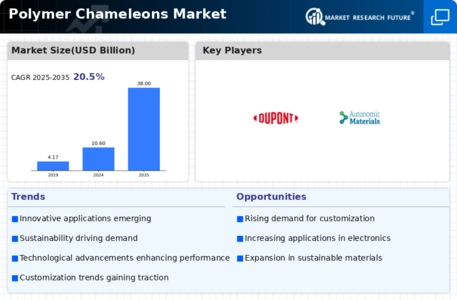Top Industry Leaders in the Polymer Chameleons Market
 In the world of coatings, where color reigns supreme, polymer chameleons are the captivating actors, changing hues like magical prisms with every shift of light. Let's delve into this mesmerizing domain, exploring the key players, their winning strategies, and the factors that determine who gets to shine the brightest.
In the world of coatings, where color reigns supreme, polymer chameleons are the captivating actors, changing hues like magical prisms with every shift of light. Let's delve into this mesmerizing domain, exploring the key players, their winning strategies, and the factors that determine who gets to shine the brightest.
Key Players and Winning Strategies:
Global Titans: Companies like Akzo Nobel (Netherlands), Evonik Industries AG (Germany), BASF SE (Germany), DuPont (US), and Honeywell International Inc. (US) hold significant market share, leveraging their vast production capacities, diverse product portfolios, and established global distribution networks. Akzo Nobel, for instance, dominates the automotive segment with its high-performance Chameleon™ series.
Regional Champions: Players like Zhejiang Cenode New Material Technology Co. Ltd. (China) and Huazhu Group (China) excel in specific regions, capitalizing on local manufacturing advantages and cultural preferences. Huazhu caters to the budget-conscious Chinese market with its cost-effective chameleon pigments.
Sustainability Champions: Emerging players like Cenospheres International and Earth Colour Company are carving a niche through eco-friendly offerings. Cenospheres International focuses on replacing petroleum-based pigments with unique cenosphere-based options, while Earth Colour Company utilizes recycled materials in its formulations.
Niche Specialists: Smaller players like Elkem ASA (Norway) and ColorLogic (US) push boundaries with cutting-edge advancements. Elkem offers high-tech pigments with specialized functionalities like thermal regulation and anti-counterfeiting, while ColorLogic focuses on customized color-shifting solutions for specific applications.
Factors Shaping Market Share:
-
Performance and Versatility: Offering pigments with vibrant color shifts, high durability, weather resistance, and compatibility with various binders is crucial for success. Akzo Nobel's chameleons exemplify this focus.
-
Sustainability and Environmental Footprint: Reducing carbon footprint, minimizing harmful chemical usage, and utilizing renewable feedstocks are becoming essential criteria for market penetration, driven by stricter regulations and eco-conscious consumers. Cenospheres International and Earth Colour Company resonate with this trend.
-
Cost-Effectiveness and Value Proposition: Balancing high performance with competitive pricing is vital, particularly in price-sensitive segments like consumer goods. Huazhu's success hinges on its cost-effective pigment offerings.
-
Technological Advancements and Applications: Constant research and development into new pigment formulations with novel functionalities, like self-healing or light-emitting properties, opens up new avenues for market growth. Elkem's specialized pigments illustrate this trend.
Key Players
- BASF SE
- DuPont de Nemours Inc.
- Evonik Industries AG
- Akzo Nobel N..v
- Autonomic Materials Inc.
- Huntsman International LLC.
- High Impact Technology LLC
- Honeywell International Inc
- MacDermid Autotype Ltd
- LyondellBasell Industries Holdings B.V.
- Chameleon International Search Limited
- Commonwealth Scientific and Industrial Research OrganisationSMP Technologies Inc.
- TOPAS Advanced Polymers/Polyplastics
- ULTROXA Polymers
Recent Developments
-
September 2023: Cenospheres International secures funding to scale up its cenosphere-based chameleon pigment production, aiming to disrupt the market with its high-performance and eco-friendly solutions.
-
October 2023: Elkem partners with a leading manufacturer of sporting goods to develop customized chameleon pigments with temperature-regulating properties for sportswear. -
November 2023: ColorLogic introduces a revolutionary digital platform for creating bespoke color-shifting effects, catering to the growing demand for personalization.
-
December 2023: The American Coatings Association releases a white paper on best practices for ethical sourcing and production of chameleon pigments, promoting transparency and responsible manufacturing throughout the supply chain.

